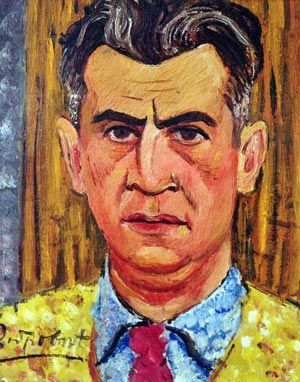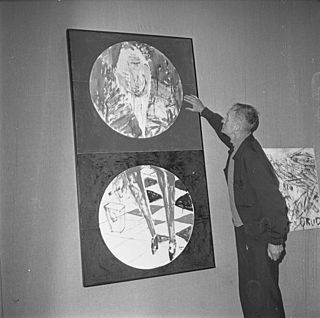External links
- Tale Art Museum official website
- Book information Amazon: The Art of Petar Tale
- Microfilmaker Magazine: Filmcritique of the documentary film That I Stay For
Petar Tale (born August 15, 1947) is a Norwegian painter.
He was born Petar Pavicevic in Montenegro but has been living in Norway since 1977. Tale's artwork consists of drawings, watercolours and paintings. The motifs are both figurative — landscapes, people — and non-figurative. He established Lillestrøm kunstmuseum — Tale Art Museum in the mid 1980s.

Expressionism is a modernist movement, initially in poetry and painting, originating in Northern Europe around the beginning of the 20th century. Its typical trait is to present the world solely from a subjective perspective, distorting it radically for emotional effect in order to evoke moods or ideas. Expressionist artists have sought to express the meaning of emotional experience rather than physical reality.

The culture of Norway is closely linked to the country's history and geography. The unique Norwegian farm culture, sustained to this day, has resulted not only from scarce resources and a harsh climate but also from ancient property laws. In the 19th century, it brought about a strong romantic nationalistic movement, which is still visible in the Norwegian language and media. In the 19th century, Norwegian culture blossomed as efforts continued to achieve an independent identity in the areas of literature, art and music. This continues today in the performing arts and as a result of government support for exhibitions, cultural projects and artwork.

Petar Dobrović was a Serbian painter and politician.
Events from the year 1909 in art.

Petar Lubarda ; 27 July 1907 – 13 February 1974) was a Serbian painter born in Ljubotinj Cetinje.

Adolph Tidemand was a noted Norwegian romantic nationalism painter. Among his best known paintings are Haugianerne and Brudeferd i Hardanger, painted in collaboration with Hans Gude.

Petar Mazev was a Macedonian academic painter, who is considered one of the most important postwar painters who introduced new energy into contemporary Macedonian art.
The Bay Area Figurative Movement was a mid-20th Century art movement made up of a group of artists in the San Francisco Bay Area who abandoned working in the prevailing style of Abstract Expressionism in favor of a return to figuration in painting during the 1950s and onward into the 1960s.
Jeremy Caniglia is an American figurative painter and illustrator, primarily in fantasy and horror genres. He has done book and magazine illustration, conceptual artwork, book and album covers, and comic books, and his work is in several important public collections including the Joslyn Art Museum and Iowa State University. His art has also been shown at the Society of Illustrators' Museum of Illustration.

New York Figurative Expressionism is a visual arts movement and a branch of American Figurative Expressionism. Though the movement dates to the 1930s, it was not formally classified as "figurative expressionism" until the term arose as a counter-distinction to the New York–based postwar movement known as Abstract Expressionism.
Robert Longhurst is an American sculptor who was born in Schenectady, New York in 1949. At an early age he was fascinated by his father's small figurative woodcarvings.

American Figurative Expressionism is a 20th-century visual art style or movement that first took hold in Boston, and later spread throughout the United States. Critics dating back to the origins of Expressionism have often found it hard to define. One description, however, classifies it as a Humanist philosophy, since it is human-centered and rationalist. Its formal approach to the handling of paint and space is often considered a defining feature, too, as is its radical, rather than reactionary, commitment to the figure.

Ludvig Eikaas was a Norwegian painter, graphic artist and sculptor. Eikaas was among the first artists in Norway to work in a purely non-figurative idiom.
Božidar Rašica was an architect, scenographer and painter.
Jason deCaires Taylor is a British sculptor and creator of the world's first underwater sculpture park – the Molinere Underwater Sculpture Park – and underwater museum – Cancún Underwater Museum (MUSA). He is best known for installing site-specific underwater sculptures that develop naturally into artificial coral reefs, which local communities and marine life depend on. Taylor integrates his skills as a sculptor, marine conservationist, underwater photographer and scuba diving instructor into each of his projects. By using a fusion of Land Art traditions and subtly integrating aspects of street art, Taylor produces dynamic sculptural works that are installed on the ocean floor to encourage marine life, to promote ocean conservation and to highlight the current climate crisis.

Fantasycoffins or figurative coffins, also called “FAVs” and custom, fantastic, or proverbial coffins, are functional coffins made by specialized carpenters in the Greater Accra Region of Ghana. These colorful objects, which developed out of figurative palanquins, are not only coffins but considered works of art. They were shown for the first time to a wider Western public in the exhibition Les Magiciens de la terre at the Musée National d'Art Moderne in Paris in 1989. The seven coffins shown in Paris were made by Kane Kwei (1922–1992) and his former assistant Paa Joe. Since then, coffins by Kane Kwei, his grandson Eric Adjetey Anang, Paa Joe, Daniel Mensah, Kudjoe Affutu, Theophilus Nii Anum Sowah, Benezate, and other artists have been displayed in international art museums and galleries around the world.

Bård Breivik was a Norwegian sculptor and art instructor.

Lars Widenfalk is a Swedish artist who works as a sculptor in Sweden, the Czech Republic and Italy. He is considered to have helped renewed figurative expression in Nordic sculpture. He works with many materials, from bronze, snow and ice. But his main material is stone, usually marble and granite. In recent years, he has also worked with glass. He is married to the Czech artist Alena Matejka.

Matthijs Nicolaas Röling is a Dutch painter, active as graphic designer, wall painter, painter, draftsman, lithographer, pen artist, etcher, and academy lecturer. He is considered a kindred spirit of the 3rd generation of the Dutch Group of figurative abstraction. Röling is described as the "figurehead of contemporary figurative painting in the Netherlands."